Moira Butterfield's Blog, page 73
January 20, 2014
Digging Deep - Winter on Picture Book Island by Malachy Doyle

Back in July I wrote a blog called Summer on Picture Book Island. A number of people said ‘Oh, you lucky thing!’
But Jonathan Allen, ever the sceptic, said ‘Yeah, but I bet it’s not like that in the depths of winter.’ So here’s an update.
7 a.m. Dog yapping downstairs - ‘I want my breakfast!’ Writer puts earplugs in, and tries to ignore her.
7.15 a.m. Dog ups the decibels. Writer tumbles from warm bed. In dressing gown and slippers, he descends to the chill of the kitchen. (It's the artist's dressing gown, by the way. Writer's one got peed on by the cat and is in the washing machine. Long story. And I know I look silly in it.)

7.30 a.m. Menagerie now fed. Time to feed writer – muesli, orange juice, lapsang souchong, toast and tawny orange marmalade. Writer is a creature of habit. Reads last of the last Alice Munro, and sighs. (Watched over by grandson - who came to stay over Christmas, bringing untold delight).
8 a.m. Writer riddles rayburn (not allowed to do so before eight as it wakes the artist, sleeping above). Gets the heat of the house going and brings artist her first mug of tea.
8.30 a.m. Writer switches on computer. Checks email. Has quick read of current picture book. Changes ‘gone’ to ‘flown’. Hyphenates ‘hot-air’. Smiles.
9 a.m. Writer brings tea two to artist. Dons running gear. Running is writer’s latest obsession. He aims to celebrate his 60thbirthday, in June, by completing his first marathon. Is writer mad?

9.10 a.m. Sets out, with dog, into the crisp, chilly air. Up the lane, past the holiday cottages, along the road, over the sand dunes, across the beach, past the cemetery and home. 5k. Under 25 minutes. Not bad for an old fella.
9.50 a.m. Writer lets the ducks out. Two eggs. Artist has risen, as has the temperature (inside). Time for shower and second breakfast.
10.30 a.m. Back to the story. Working on it for two months now. Initially it involved a trip to the zoo. Agent liked the idea, but felt that zoo was ‘tacked on’ and asked writer to ‘find an adventure that grows organically out of the core idea… so it all ties indivisibly together and resonates with that core idea more directly and more meaningfully’ Serious business, this picture book lark. Doesn’t get any easier, no matter how long you’ve been at it.
So the zoo disappeared. Prose turned to rhyme - sometimes you just can’t stop it - and a new plot appeared, involving cupcakes. Agent’s view? ‘It’s starting to get somewhere. The domestic set-up is beautifully done, and funny too. But the second half feels undercooked.’ A pun on cupcakes, presumably - agent has a wry humour. ‘Ending feels more like a twist or punchline than a real ending that ties things up. It feels closer to the core of the idea, but I need you to dig deeper!’
Thunder, lightning and emotional depth added. Agent liked it. Tried it out on publisher. Who said, ‘Here we have the beginning of a potentially appealing character around whom an emotionally expansive story could be written. But, as it currently stands, it doesn’t take the reader far enough. In fact, it doesn’t really take them anywhere.’ Oh dear.
Agent said, ‘Go find a new story that gets right to the core of what it feels like to be that character. DIG DEEPER!’
The story has to fly, and that’s where the hot-air balloon comes in. I’m digging, digging, digging, and I know I’ve got to get there this time. There’s only so many times you can to-and-fro a piece before people lose faith in it.
12.30 p.m. Lunchtime. Sitting round the rayburn, with soda bread and beetroot soup. It’s winter on Picture Book Island. A time of wind and rain, of hail and storm, of occasional frost and even more occasional snow. A time for wrapping up warm. For bedding down and digging deeper.
But already snowdrops are peeping up through the cold cold soil. Already daffodils are shooting, and montbretia, a blaze of orange later in the year, is pushing its way out.
And my story’s finding its form. At last it's finding its form.
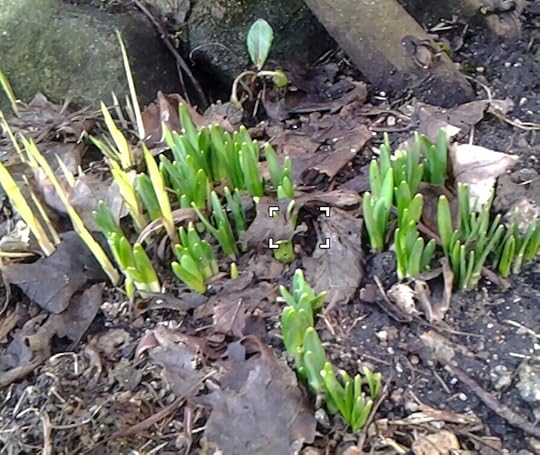
P.S. Snowy pix are from a previous winter. Never let the truth get in the way of a good story.
Malachy is pleased to announce that The Snuggle Sandwich, his picture book with the illustrator Gwen Millward, has been shortlisted for the Dundee Picture Book Award.
Also his most recent picture book, Too Noisy, with Ed Vere, has been nominated for the Greenaway Award.
Published on January 20, 2014 00:18
January 15, 2014
A Picture Is Worth A Thousand Words - Lynne Garner
A friend recently posted a cute animal photo on my Facebook page. As soon as I saw it I just knew I had to use it as a basis for a picture book story. So I grabbed a sheet of A4 paper and divided into 12 sections (I tend to write the traditional 12 double page spreads). I started to plot my story, which started well. However when I reached the last page I stalled. I had the image in my minds eye, I knew what action was taking place but I just couldn't put it into words. I decided to put the story to one side and allow my subconscious solve the issue for me. However a week or so went by and I was still stuck. Suddenly it hit me. The page didn't need words, the picture could show the reader what I wanted them to know.
I'm not the only author to let the picture tell the story. In the hands of the right illustrator the story can be told successfully without a single word on the page. For example in one of my favourite pictures books The Big Bad Mole's Coming! written by Martin Waddell and illustrated by John Bendall-Brunello there are two pages that contain no words (part of one page below). The action needs no words, I can tell exactly how the animals are feeling from their body language.

Another book that uses this device is Knight Time written by Jane Clarke and illustrated by Jane Massey. The page is a fold out page which opens to reveal a second page with text. Jane informs me the idea was that as the reader turned the page they would feel they were entering the forest where Little Knight and Little Dragon are lost. As you can see from the page below you don't need words to feel the tingle run up your spine and to start to worry about the main characters.

So to all those picture book writers out there. If you're working on a new picture book story and stall ask yourself "can a picture paint the words I need?" If the answer is yes then don't be afraid to allow the illustrations to tell the story for you.
Lynne Garnerwww.lynnegarner.com
I also write for: Authors Electric - covers digital self-publishing Awfully Big Blogging Adventure - the ramblings of a few scattered authors The Hedgehog Shed - concerned with hedgehog rescueFuelled By Hot Chocolate - my own ramblingsThe Craft Ark - craft how-to blog
My online classes with WOW starting March 2014:How To Write A Children's Picture Book And Get Published (beginners)5 Picture Books In 5 Weeks (advanced)How To Write A Hobby-based How To Book
I'm not the only author to let the picture tell the story. In the hands of the right illustrator the story can be told successfully without a single word on the page. For example in one of my favourite pictures books The Big Bad Mole's Coming! written by Martin Waddell and illustrated by John Bendall-Brunello there are two pages that contain no words (part of one page below). The action needs no words, I can tell exactly how the animals are feeling from their body language.

Another book that uses this device is Knight Time written by Jane Clarke and illustrated by Jane Massey. The page is a fold out page which opens to reveal a second page with text. Jane informs me the idea was that as the reader turned the page they would feel they were entering the forest where Little Knight and Little Dragon are lost. As you can see from the page below you don't need words to feel the tingle run up your spine and to start to worry about the main characters.

So to all those picture book writers out there. If you're working on a new picture book story and stall ask yourself "can a picture paint the words I need?" If the answer is yes then don't be afraid to allow the illustrations to tell the story for you.
Lynne Garnerwww.lynnegarner.com
I also write for: Authors Electric - covers digital self-publishing Awfully Big Blogging Adventure - the ramblings of a few scattered authors The Hedgehog Shed - concerned with hedgehog rescueFuelled By Hot Chocolate - my own ramblingsThe Craft Ark - craft how-to blog
My online classes with WOW starting March 2014:How To Write A Children's Picture Book And Get Published (beginners)5 Picture Books In 5 Weeks (advanced)How To Write A Hobby-based How To Book
Published on January 15, 2014 01:33
January 9, 2014
A Family Affair by Coral Rumble
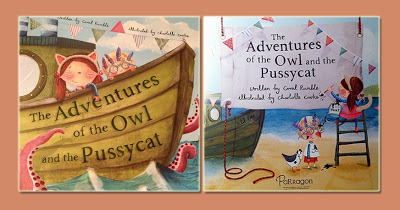
In October 2013, I had the great pleasure of seeing my picture book, The Adventures of the Owl and the Pussycat, published by Parragon. What made it even more exciting, was the fact that it wasn’t just my book, but a collaboration with my illustrator daughter, Charlotte Cooke. When she was still at uni, her tutors strongly encouraged her to submit an entry for the Macmillan Prize. Although she felt reluctant, because of other work pressures, she decided to play with an idea she’d had. At this point, Charlotte commented to me, ‘It says in the rules you can work with an author’, and so the die was cast! (She was, incidentally, awarded Highly Commended by Macmillan, and was exhibited with the other successful illustrators. Very handy for promoting a new girl on the block!)
As you might have gathered, our book is loosely based on the well-known, classic Lear poem. In fact ‘based’ is probably too strong a word as, although we use the titular characters in the story, they are, in fact, two children playing dress-up as an owl and pussycat. The text touches base with the original poem at the beginning and end. I wanted to echo some of the lines, and use the original iambic pentameter, to ease in and out of the adventure, and to suggest to parents the inspiration for the children’s role play. The rest of the poem takes the reader or listener on a quirky adventure, over and under the sea. The metre changes to a quicker pace, as we dance from one scenario to the next, with lines containing caesuras to create a seesaw effect. I thought the rocking effect might help a stressed parent at bedtime!
The most satisfying thing for us both, is that the book seems to have really caught the imagination of children, in just the way we had hoped. We wanted it to be a springboard for imaginative play. Charlotte’s beautiful illustrations are both detailed and humorous, and enlarge the possibilities for story development. We’ve been excited to hear of children dressing up for their own sea adventures:

Writing is often a solitary act, so working alongside someone else is a treat. When the ‘someone else’ is your daughter, it’s a double blessing o
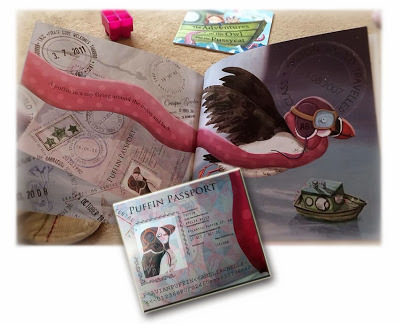 So, what started off as a vague idea in Charlotte’s head, and my desire to give her some text to illustrate for a competition, developed into a labour of love for us both. I’ve worked for many years as a poet, and never expected to work with my daughter. I think we’ve both learnt much in the process, as her career is just blossoming, and this is my first picture book. It has truly been an unexpected adventure!
So, what started off as a vague idea in Charlotte’s head, and my desire to give her some text to illustrate for a competition, developed into a labour of love for us both. I’ve worked for many years as a poet, and never expected to work with my daughter. I think we’ve both learnt much in the process, as her career is just blossoming, and this is my first picture book. It has truly been an unexpected adventure! Coral Rumble has had 3 poetry collections published, and has contributed to 100+ anthologies. She often writes for Cbeebies TV and radio, and is featured in Favourite Poets (Hodder Children's Books). Michael Rosen has commented, "Rumble has a dash and delight about her work."
www.caterpillartales.co.uk/the-adventures-of-the-owl-and-the-pussycat-review/www.coralrumble.co.uk www.charlottecookeillustration.blogspot.com www.poetryzone.co.uk
Published on January 09, 2014 23:30
January 5, 2014
New Year's Revolution... Resolving to do it all again -tidier house, be more organised, oh yes, and write some lovely picture books, by Juliet Clare Bell
Happy New Year!
I’ve always loved New Year’s Eve and New Year: reflecting on the previous year, and even more fun, the promise of exciting things to come. It’s such an optimistic time. I know lots of people don’t, but I love new year’s revolutions (as a child I used to think that’s what they were called –and that’s how they can feel sometimes). I love them, even if they don’t quite turn into what they set out to be...
One thing about writing for a blog is that you become slightly more accountable for your resolutions, which can be a great thing, or it can make you look a little foolish. I was thinking about this blog post and what I’d put in when I realised I’d done one last year at new year so I checked it out...
...oops. Most of the same things.
I’d posted a picture of my newly tidied desk:
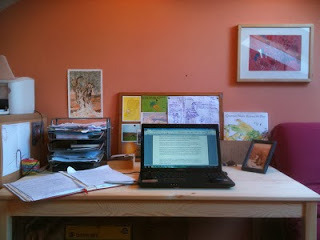
I had a great weekly plan which was making me much more productive:
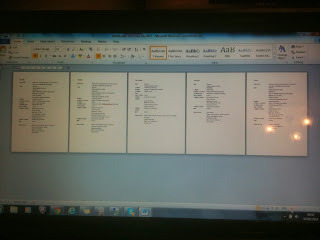
I had a calendar and I was determined to use it!
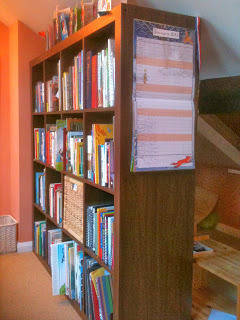
To be fair, for several months I did do all those things and it was brilliant. The house was tidier than it had ever been, I was much more focused... but I can pretty much sum up the whole of the rest of the year from March 12th onwards in three words: my mum died. And that was 2013.
I’m mighty glad to be starting 2014. It feels like a good time to try and get on top of things again, and actually not all plans for being more organised (and having a more sorted house and working environment) at the beginning of 2013 came to nothing. I'm going to restart my weekly plan that worked so well for a while, and I am at a better physical starting place (I can’t un-chuck all the masses of stuff I chucked out last January, so although there’s a long way to go, the house is in a much better state than it was a year ago). And good things did happen in 2013, including getting an office over the road with fellow children’s author, Leila Rasheed.
Writing goals for 2014
In our end of year local SCBWI (Society of Children’s Book Writers and Illustrators) meet up in December, we discussed our personal plans for 2014 and what had worked well/not so well for us in 2013. I realised that my three writing goals for 2014 are actually not even writing goals, but creating a better environment where I hope the writing will slightly take care of itself...
[1] Use a calendar properly . To many people, this seems ridiculous, but I still struggle with writing things down in one place and not carrying around most dates in my head. I spend half the time not using any calendars at all, and the other half, trying to use loads at the same time (two wall calendars –home and office; a diary; notes on my phone; the calendar on my phone; google calendar; a wall planner). Not this year! I’m going to try and master google calendar and pretty much use that and a wall planner (for all you organised people, if you’ve got any good tips, please please leave them in the comments...)
[2] Use a to-do list properly. If someone’s got the perfect to-do list system, please elaborate in the comments... I’ve just signed up to the free version of Simpleology (on the recommendation of other picture book writers) and I’m going to try using it every day for a few months to see if it actually helps (or whether it’s just another way of procrastinating).
[3] Staying on top of accounts. This has taken up ridiculously more thinking time than it ever needed to. I think I’ve realised that it’s actually all pretty straightforward –you just have to do it and keep doing it and have a spreadsheet and DO IT. And not waste time thinking about it and JUST DO IT!
I guess that sums it up for 2014: just do it. Oh, and also my favourite quote from David Almond at a talk he gave in Birmingham in November, in response to the question by a young girl on what should she do if she wanted to become a writer: "Make it lovely".
2014’s definitely going to be a happier year. There are lots of exciting things coming up on the writing front -once a fortnight, starting this month, Leila and I are hosting day-long writing retreats, where writers/illustrators can come and write in the (quiet) company of other writers; once a month, we’re doing an SCBWI-equivalent up at the new Library of Birmingham; I’m running another picture book writing evening class starting in a few weeks; I’ve got some lovely author visits lined up, including a really exciting one on World Book Day, and I’ve been commissioned to write a really exciting non-fiction picture book, which I’ve been doing lots of (delicious) research for and which I’m going to blog about in March. And Tara Lazar’s brilliant PiBoIdMo from November 2013 has left me with lots of new shoots for new stories which I’ll keep watering over the coming months...
Happy New Year! and make it lovely...
What are your writing goals for this year? Do you have any hints on doing a to do list well, or using a calendar efficiently?
Juliet Clare Bell is currently writing a picture book on Bournville, the Cadburys and chocolate, which is fascinating and very tasty...
I’ve always loved New Year’s Eve and New Year: reflecting on the previous year, and even more fun, the promise of exciting things to come. It’s such an optimistic time. I know lots of people don’t, but I love new year’s revolutions (as a child I used to think that’s what they were called –and that’s how they can feel sometimes). I love them, even if they don’t quite turn into what they set out to be...
One thing about writing for a blog is that you become slightly more accountable for your resolutions, which can be a great thing, or it can make you look a little foolish. I was thinking about this blog post and what I’d put in when I realised I’d done one last year at new year so I checked it out...
...oops. Most of the same things.
I’d posted a picture of my newly tidied desk:

I had a great weekly plan which was making me much more productive:

I had a calendar and I was determined to use it!

To be fair, for several months I did do all those things and it was brilliant. The house was tidier than it had ever been, I was much more focused... but I can pretty much sum up the whole of the rest of the year from March 12th onwards in three words: my mum died. And that was 2013.
I’m mighty glad to be starting 2014. It feels like a good time to try and get on top of things again, and actually not all plans for being more organised (and having a more sorted house and working environment) at the beginning of 2013 came to nothing. I'm going to restart my weekly plan that worked so well for a while, and I am at a better physical starting place (I can’t un-chuck all the masses of stuff I chucked out last January, so although there’s a long way to go, the house is in a much better state than it was a year ago). And good things did happen in 2013, including getting an office over the road with fellow children’s author, Leila Rasheed.
Writing goals for 2014
In our end of year local SCBWI (Society of Children’s Book Writers and Illustrators) meet up in December, we discussed our personal plans for 2014 and what had worked well/not so well for us in 2013. I realised that my three writing goals for 2014 are actually not even writing goals, but creating a better environment where I hope the writing will slightly take care of itself...
[1] Use a calendar properly . To many people, this seems ridiculous, but I still struggle with writing things down in one place and not carrying around most dates in my head. I spend half the time not using any calendars at all, and the other half, trying to use loads at the same time (two wall calendars –home and office; a diary; notes on my phone; the calendar on my phone; google calendar; a wall planner). Not this year! I’m going to try and master google calendar and pretty much use that and a wall planner (for all you organised people, if you’ve got any good tips, please please leave them in the comments...)
[2] Use a to-do list properly. If someone’s got the perfect to-do list system, please elaborate in the comments... I’ve just signed up to the free version of Simpleology (on the recommendation of other picture book writers) and I’m going to try using it every day for a few months to see if it actually helps (or whether it’s just another way of procrastinating).
[3] Staying on top of accounts. This has taken up ridiculously more thinking time than it ever needed to. I think I’ve realised that it’s actually all pretty straightforward –you just have to do it and keep doing it and have a spreadsheet and DO IT. And not waste time thinking about it and JUST DO IT!
I guess that sums it up for 2014: just do it. Oh, and also my favourite quote from David Almond at a talk he gave in Birmingham in November, in response to the question by a young girl on what should she do if she wanted to become a writer: "Make it lovely".
2014’s definitely going to be a happier year. There are lots of exciting things coming up on the writing front -once a fortnight, starting this month, Leila and I are hosting day-long writing retreats, where writers/illustrators can come and write in the (quiet) company of other writers; once a month, we’re doing an SCBWI-equivalent up at the new Library of Birmingham; I’m running another picture book writing evening class starting in a few weeks; I’ve got some lovely author visits lined up, including a really exciting one on World Book Day, and I’ve been commissioned to write a really exciting non-fiction picture book, which I’ve been doing lots of (delicious) research for and which I’m going to blog about in March. And Tara Lazar’s brilliant PiBoIdMo from November 2013 has left me with lots of new shoots for new stories which I’ll keep watering over the coming months...
Happy New Year! and make it lovely...
What are your writing goals for this year? Do you have any hints on doing a to do list well, or using a calendar efficiently?
Juliet Clare Bell is currently writing a picture book on Bournville, the Cadburys and chocolate, which is fascinating and very tasty...
Published on January 05, 2014 02:00
December 31, 2013
This year I'm cutting down on clutter by Jane Clarke
Happy New Year!
My new year's resolution is to attempt to cut down on some of the clutter in my study. This year, I plan to:
This year, I plan to:
Get a proper prop box for the props I take on school visits as they have overflowed from my little suitcase.
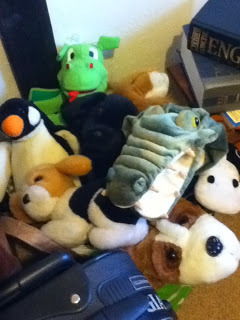
Recycle papers and magazines and store pics that interest me on Pinterest instead. National Geographics are off to the charity shop.
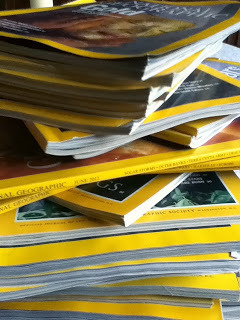
Send a pile of foreign language editions somewhere useful. Any ideas where?
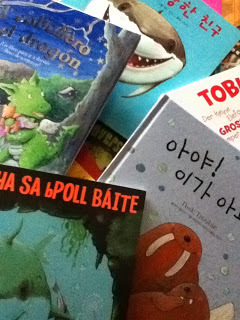
And finally…
This year, I WILL try to sort out my notebooks stuffed full of half-baked ideas. Has anyone tried organising picture book ideas in Schrivener or any other software?
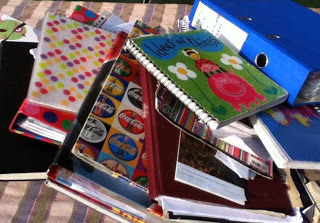
May your 2014 be full of fantastic picture books! There's always room for more of those …
Jane's currently working on three picture book texts to be published by Nosy Crow in 2015, and has just had a mini-series of board books accepted by Random House.
My new year's resolution is to attempt to cut down on some of the clutter in my study.
 This year, I plan to:
This year, I plan to:Get a proper prop box for the props I take on school visits as they have overflowed from my little suitcase.

Recycle papers and magazines and store pics that interest me on Pinterest instead. National Geographics are off to the charity shop.

Send a pile of foreign language editions somewhere useful. Any ideas where?

And finally…
This year, I WILL try to sort out my notebooks stuffed full of half-baked ideas. Has anyone tried organising picture book ideas in Schrivener or any other software?

May your 2014 be full of fantastic picture books! There's always room for more of those …
Jane's currently working on three picture book texts to be published by Nosy Crow in 2015, and has just had a mini-series of board books accepted by Random House.
Published on December 31, 2013 23:00
December 27, 2013
It's Christmas story time with some favourite Books - Linda Strachan
This Christmas which picture books did you give, share or discover? I thought I would share some Christmas presents and some books that are favourites.
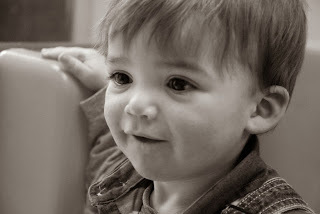 Little Ruaridh is 2 years old and he just loves tractors and diggers.
Little Ruaridh is 2 years old and he just loves tractors and diggers.For Christmas this year he got his own copy of a book he had enjoyed when they borrowed it from their local library.
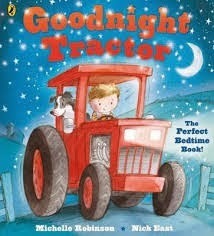
It was Goodnight Tractor by Michelle Robinson and Nick East. He also got a copy of Goodnight Digger. These are part of a series of books all very similar in style with gentle rhyme.
Goodnight Tractor and the other books in this series work in the same way that parents have often encouraged children to settle down to sleep, by saying goodnight to their toys before going to bed.
'....goodnight pig and goodnight sheep... goodnight tractor time to sleep.'
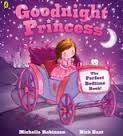
Ruaridh loves them and it does settle him down to sleep. He also loves Goodnight Princess, as does his sister, Abigail.
Abigail is 4 and loves her books. One of her favourites this year has been Julia Donaldson's Jack and the Flumflum Tree, illustrated by David Roberts
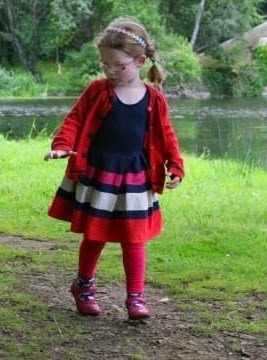
Jack heads off in search of the fruit of the Flumflum tree to cure his Moozles and encounters all sorts of problems but he has his granny's patchwork sack filled with a strange assortment of things that prove to be just what he needs in every situation!
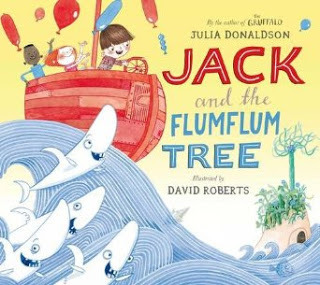
Poppy is 3 and she also loves her stories.
Jack and the Flumflum Tree has recently been on her reading list as she recovered from her own Moozles!
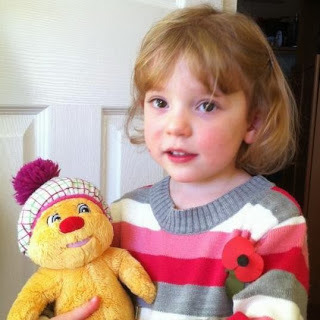
Another favourite is Giraffes Can't Dance by Giles Andreae and Guy Parker-Rees.
 As you can see in the picture,she also loves Hamish McHaggis and likes to keep him close by at night because she knows he keeps her safe from bad dreams and her little brother Benedict has his own little Hamish, too!
As you can see in the picture,she also loves Hamish McHaggis and likes to keep him close by at night because she knows he keeps her safe from bad dreams and her little brother Benedict has his own little Hamish, too! 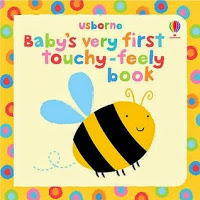
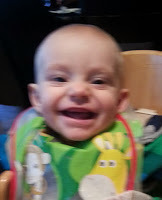 Baby Benedict is 7 months this Christmas and he is just getting the hang of books. He has inherited a lot of his big sister's books but his Christmas presents included Usborne's Baby's Very First Touchy-feely Book. One of the many great books for tinies with textures to touch, and bright colours and images.
Baby Benedict is 7 months this Christmas and he is just getting the hang of books. He has inherited a lot of his big sister's books but his Christmas presents included Usborne's Baby's Very First Touchy-feely Book. One of the many great books for tinies with textures to touch, and bright colours and images.So this Christmas which picture books did you give, share or discover?
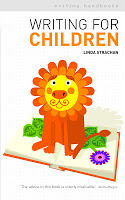
Linda Strachan is the award winning author of over 60 books for all ages, from picture books to YA novels, and writing handbook Writing For Children
Website www.lindastrachan.com
Blog BOOKWORDS
Published on December 27, 2013 15:56
December 21, 2013
Picture This by Abie Longstaff
This is just a little post to highlight a small, but fantastic, exhibition at the British Library.
‘Picture This’ closes on the 26thof January so, if you love illustration and you haven’t seen it yet, I really recommend a visit (and it’s free!).
In reviews of picture books the emphasis is so often on words rather than illustration, but this exhibition focuses entirely on the pictures; with original artwork, old books and video interviews.
In an age of ebooks, there’s something quite awe-inspiring about being a few centimetres away from classic illustrators’ work such as this wonderful drawing of Willy Wonka by Quentin Blake, from Charlie and the Chocolate Factory:
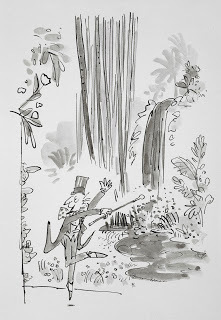
As well as showcasing the art, the exhibition also looks at how well-know characters from books have been interpreted and reinterpreted over the years.
This is David Roberts's take on Mole from Wind in the Willows:
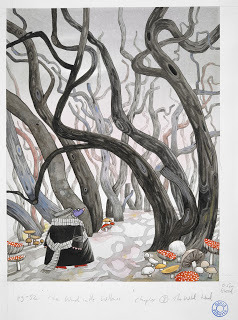 There are more pictures of the exhibition on the BritishLibrary Facebook page.
There are more pictures of the exhibition on the BritishLibrary Facebook page.Have a lovely Christmas!
Published on December 21, 2013 00:23
December 16, 2013
Names, or no names. . . by Jonathan Allen
The impact of names in children's books is something that I hadn't thought about particularly until I read an article about the stage version of Maurice Sendak's 'Where The Wild Things Are'.
In the article, Sendak talked about how he felt he couldn't stage direct his creatures until they had defined personalities. To this end he felt they needed to have names. Not overtly in the script, but just as a personal device to help their coming alive as animated beings feel more convincing. Hooks to hang their behavioral characteristics on if you like.
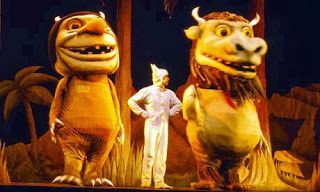
It was interesting that there was felt to be no need for this naming in the actual book, ( or come to think of it, in Sendak's head at the time of writing and drawing it ). Maybe because the creatures weren't differentiated in the book, they were the Wild Things, and didn't need the distraction of having different personalities.
Anyway, that is by the by. What was really fascinating to me, and revealing about my own mental blind spots etc, were the names he chose. I may not have the first one exactly right but you will get the idea. He chose the names Aaron, Moysha and Tzippy.
Because of my lack of examination of my own cultural bias, or awareness that I even had much of one, I was surprised. The surprise was only momentary, But my inner self monitoring process clocked it! I gave myself a clip round the ear. Why on earth should it be even remotely surprising that a Jewish author would give his creations Jewish names?
On further consideration, I came to the conclusion that it was the baggage that comes with names that had struck me. Suddenly, Sendak's creatures had ethnicity! They were no longer universal creatures from the imagination in quite the same way.
This made me think up all sorts of names for the creatures and see what difference that made to my view of them. What if they were Alf, Bert and Norman, or Rory, Torquil and Hector? What if they were Gudeep, Arshad and Divinda, or Lloyd, Winston and Curtley? etc etc. Or what, heaven forfend, if they were girls? ;-)
It does seem that a seething morass of entirely subjective cultural bias, class bias, and unsubstantiated preconceptions is invoked every time a name is used! (If you can evoke a morass. . . Look, I like mixed metaphors!)
I have been steering clear of names in my own work for a long time without really examining why. It just felt right. It's nice to know that my unconscious was on the ball. . .
I think it is similar to choosing animals as protagonists in your books, as I tend to do. By using animals, you avoid the class, culture, and gender issues that depicting children can stir up. These issues can distract from the story or the point of a book and threaten to spoil it. I find that by using non-names like Baby Owl and Little Puffin as well, I can neatly sidestep these distractions for a second time.
ps - Not that there is anything wrong with names used in the full awareness of their 'baggage'. 'Peter Rabbit' is set in a particular time and place, as is Shirley Hughes 'Alfie' and many others. And they are great. I just can't imagine 'Denis the Gruffalo' working all that well. . .
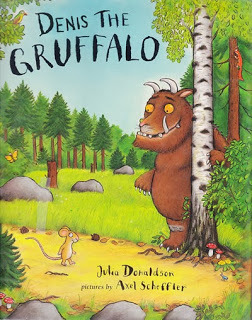
In the article, Sendak talked about how he felt he couldn't stage direct his creatures until they had defined personalities. To this end he felt they needed to have names. Not overtly in the script, but just as a personal device to help their coming alive as animated beings feel more convincing. Hooks to hang their behavioral characteristics on if you like.

It was interesting that there was felt to be no need for this naming in the actual book, ( or come to think of it, in Sendak's head at the time of writing and drawing it ). Maybe because the creatures weren't differentiated in the book, they were the Wild Things, and didn't need the distraction of having different personalities.
Anyway, that is by the by. What was really fascinating to me, and revealing about my own mental blind spots etc, were the names he chose. I may not have the first one exactly right but you will get the idea. He chose the names Aaron, Moysha and Tzippy.
Because of my lack of examination of my own cultural bias, or awareness that I even had much of one, I was surprised. The surprise was only momentary, But my inner self monitoring process clocked it! I gave myself a clip round the ear. Why on earth should it be even remotely surprising that a Jewish author would give his creations Jewish names?
On further consideration, I came to the conclusion that it was the baggage that comes with names that had struck me. Suddenly, Sendak's creatures had ethnicity! They were no longer universal creatures from the imagination in quite the same way.
This made me think up all sorts of names for the creatures and see what difference that made to my view of them. What if they were Alf, Bert and Norman, or Rory, Torquil and Hector? What if they were Gudeep, Arshad and Divinda, or Lloyd, Winston and Curtley? etc etc. Or what, heaven forfend, if they were girls? ;-)
It does seem that a seething morass of entirely subjective cultural bias, class bias, and unsubstantiated preconceptions is invoked every time a name is used! (If you can evoke a morass. . . Look, I like mixed metaphors!)
I have been steering clear of names in my own work for a long time without really examining why. It just felt right. It's nice to know that my unconscious was on the ball. . .
I think it is similar to choosing animals as protagonists in your books, as I tend to do. By using animals, you avoid the class, culture, and gender issues that depicting children can stir up. These issues can distract from the story or the point of a book and threaten to spoil it. I find that by using non-names like Baby Owl and Little Puffin as well, I can neatly sidestep these distractions for a second time.
ps - Not that there is anything wrong with names used in the full awareness of their 'baggage'. 'Peter Rabbit' is set in a particular time and place, as is Shirley Hughes 'Alfie' and many others. And they are great. I just can't imagine 'Denis the Gruffalo' working all that well. . .

Published on December 16, 2013 00:42
Names, or no names. . .
The impact of names in children's books is something that I hadn't thought about particularly until I read an article about the stage version of Maurice Sendak's 'Where The Wild Things Are'.
In the article, Sendak talked about how he felt he couldn't stage direct his creatures until they had defined personalities. To this end he felt they needed to have names. Not overtly in the script, but just as a personal device to help their coming alive as animated beings feel more convincing. Hooks to hang their behavioral characteristics on if you like.

It was interesting that there was felt to be no need for this naming in the actual book, ( or come to think of it, in Sendak's head at the time of writing and drawing it ). Maybe because the creatures weren't differentiated in the book, they were the Wild Things, and didn't need the distraction of having different personalities.
Anyway, that is by the by. What was really fascinating to me, and revealing about my own mental blind spots etc, were the names he chose. I may not have the first one exactly right but you will get the idea. He chose the names Aaron, Moysha and Tzippy.
Because of my lack of examination of my own cultural bias, or awareness that I even had much of one, I was surprised. The surprise was only momentary, But my inner self monitoring process clocked it! I gave myself a clip round the ear. Why on earth should it be even remotely surprising that a jewish author would give his creations jewish names?
On further consideration, I came to the conclusion that it was the baggage that comes with names that had struck me. Suddenly, Sendak's creatures had ethnicity! They were no longer universal creatures from the imagination in quite the same way.
This made me think up all sorts of names for the creatures and see what difference that made to my view of them. What if they were Alf, Bert and Norman, or Rory, Torquil and Hector? What if they were Gudeep, Arshad and Divinda, or Lloyd, Winston and Curtley? etc etc. Or what, heaven forfend, if they were girls? ;-)
It does seem that a seething morass of entirely subjective cultural bias, class bias, and unsubstantiated preconceptions is invoked every time a name is used! (If you can evoke a morass. . . Look, I like mixed metaphors!)
I have been steering clear of names in my own work for a long time without really examining why. It just felt right. It's nice to know that my unconscious was on the ball. . .
I think it is similar to choosing animals as protagonists in your books, as I tend to do. By using animals, you avoid the class, culture, and gender issues that depicting children can stir up. These issues can distract from the story or the point of a book and threaten to spoil it. I find that by using non-names like Baby Owl and Little Puffin as well, I can neatly sidestep these distractions for a second time.
ps - Not that there is anything wrong with names used in the full awareness of their 'baggage'. 'Peter Rabbit' is set in a particular time and place, as is Shirley Hughes 'Alfie' and many others. And they are great. I just can't imagine 'Denis the Gruffalo' working all that well. . .

In the article, Sendak talked about how he felt he couldn't stage direct his creatures until they had defined personalities. To this end he felt they needed to have names. Not overtly in the script, but just as a personal device to help their coming alive as animated beings feel more convincing. Hooks to hang their behavioral characteristics on if you like.

It was interesting that there was felt to be no need for this naming in the actual book, ( or come to think of it, in Sendak's head at the time of writing and drawing it ). Maybe because the creatures weren't differentiated in the book, they were the Wild Things, and didn't need the distraction of having different personalities.
Anyway, that is by the by. What was really fascinating to me, and revealing about my own mental blind spots etc, were the names he chose. I may not have the first one exactly right but you will get the idea. He chose the names Aaron, Moysha and Tzippy.
Because of my lack of examination of my own cultural bias, or awareness that I even had much of one, I was surprised. The surprise was only momentary, But my inner self monitoring process clocked it! I gave myself a clip round the ear. Why on earth should it be even remotely surprising that a jewish author would give his creations jewish names?
On further consideration, I came to the conclusion that it was the baggage that comes with names that had struck me. Suddenly, Sendak's creatures had ethnicity! They were no longer universal creatures from the imagination in quite the same way.
This made me think up all sorts of names for the creatures and see what difference that made to my view of them. What if they were Alf, Bert and Norman, or Rory, Torquil and Hector? What if they were Gudeep, Arshad and Divinda, or Lloyd, Winston and Curtley? etc etc. Or what, heaven forfend, if they were girls? ;-)
It does seem that a seething morass of entirely subjective cultural bias, class bias, and unsubstantiated preconceptions is invoked every time a name is used! (If you can evoke a morass. . . Look, I like mixed metaphors!)
I have been steering clear of names in my own work for a long time without really examining why. It just felt right. It's nice to know that my unconscious was on the ball. . .
I think it is similar to choosing animals as protagonists in your books, as I tend to do. By using animals, you avoid the class, culture, and gender issues that depicting children can stir up. These issues can distract from the story or the point of a book and threaten to spoil it. I find that by using non-names like Baby Owl and Little Puffin as well, I can neatly sidestep these distractions for a second time.
ps - Not that there is anything wrong with names used in the full awareness of their 'baggage'. 'Peter Rabbit' is set in a particular time and place, as is Shirley Hughes 'Alfie' and many others. And they are great. I just can't imagine 'Denis the Gruffalo' working all that well. . .

Published on December 16, 2013 00:42
December 11, 2013
The Right Words by Paeony Lewis
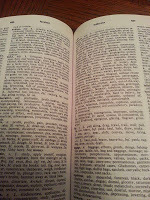 I adore words, although I appreciate ‘less is more’ with picture book stories and some texts need pruning or stubble burning. However, it’s not just about cutting a text to 200-500 words (or zero words). I think that sometimes it’s all right to stick in a seemingly unnecessary word or two, if it adds a lot to the story experience. It’s about finding the right words, and not just the right word count. Of course, concentrating on what a story is really about, and chucking out extraneous waffle also helps.
I adore words, although I appreciate ‘less is more’ with picture book stories and some texts need pruning or stubble burning. However, it’s not just about cutting a text to 200-500 words (or zero words). I think that sometimes it’s all right to stick in a seemingly unnecessary word or two, if it adds a lot to the story experience. It’s about finding the right words, and not just the right word count. Of course, concentrating on what a story is really about, and chucking out extraneous waffle also helps.You might shrug at what appears to be an obvious observation about finding the 'right words'. It is obvious, although it took me over a year of writing and learning about poetry for this obvious statement to burrow deeper into my brain. Perhaps it was a case of knowing something without truly appreciating it?
After immersing myself in contemporary poetry, I've realised my picture-book writing has morphed. I now search harder for the right words and for different ways of seeing everyday words. This makes it tougher for me to look at my old texts and revise, because the old texts feel a little alien. Weird. Maybe I’ll grow out of it?
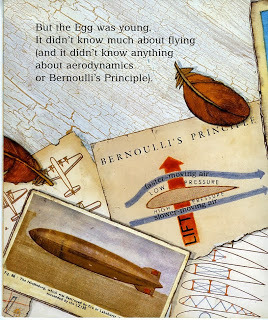 For me, the right words might be extra words, or they might be words that allow other words to be cut. They might be simple words or lush words. Picture books are written to be read aloud by an adult to a child and this can allow a richer palette of words than in an early reading book. For example, in the delightfully surreal Egg Drop by Mini Grey, there's a tongue-twisting sentence that intrigues children:
For me, the right words might be extra words, or they might be words that allow other words to be cut. They might be simple words or lush words. Picture books are written to be read aloud by an adult to a child and this can allow a richer palette of words than in an early reading book. For example, in the delightfully surreal Egg Drop by Mini Grey, there's a tongue-twisting sentence that intrigues children:It didn't know much about flying
(and it didn't know anything
about aerodynamics
or Bernoulli's Principle).
In contrast to this, Jon Klassen uses simple language with style. I adore This is Not My Hat by Jon Klassen. He uses unassuming words and pedestrian sentences, and then combines them with deceptively simple illustrations to create a thoughtful story that leaves room for the reader to ponder.
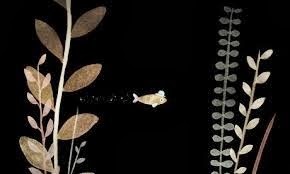 from This Is Not My Hat by Jon KlassenHere's an excerpt from a longer section. At first glance it might appear a little repetitive, but it's not. I think you can hear the child's voice and the glorious self justification.
from This Is Not My Hat by Jon KlassenHere's an excerpt from a longer section. At first glance it might appear a little repetitive, but it's not. I think you can hear the child's voice and the glorious self justification.
I know it's wrong to steal a hat.I know it does not belong to me.But I am going to keep it.It was too small for him anyway.It fits me just right.
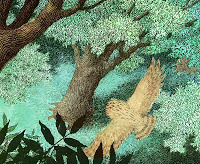 from Owl Babies, illus by Patrick BensonSometimes the right words may add to the lyrical sing-song quality of a text. In this example from Owl Babies by Martin Waddell (a steadfast favourite), the penultimate and is a 'right word', even if it appears to be an excess word. In isolation, I think the sentence below would be a little menacing without the penultimate and, yet with it, the sentence is softened and flows.
from Owl Babies, illus by Patrick BensonSometimes the right words may add to the lyrical sing-song quality of a text. In this example from Owl Babies by Martin Waddell (a steadfast favourite), the penultimate and is a 'right word', even if it appears to be an excess word. In isolation, I think the sentence below would be a little menacing without the penultimate and, yet with it, the sentence is softened and flows.
Soft and silent, she swooped through the trees to Sarah and Percy
and Bill.
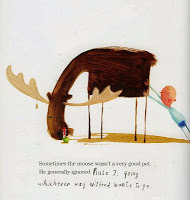 Oliver Jeffers also gives respect to the reader in This is Not My Moose. It's another of my favourites. We're told stuff, but we also smile because we understand what's also being said between the lines.
Oliver Jeffers also gives respect to the reader in This is Not My Moose. It's another of my favourites. We're told stuff, but we also smile because we understand what's also being said between the lines.Sometimes the moose wasn't a very good pet.
He generally ignored Rule 7: Going
whichever way Wilfred wants to go.
I've just noticed that three of my examples are from author/illustrators. I suspect that's just a coincidence, although I've always thought that a large proportion of the best and worst books come from people who illustrate and write. But that's only my opinion and it might be time for me to scurry away!
If anybody has examples of picture book sentences that seem to use the 'right words', I'd love to read them in the comments' section. And if you disagree with my opinions, just say!
Paeony Lewis
www.paeonylewis.com
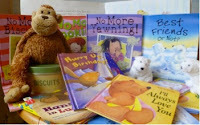
Published on December 11, 2013 00:30



